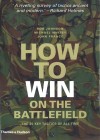How to Win on the Battlefield: The 25 Key Tactics of All Time,
Written by: Rob Johnson and Michael Whitby,
Thames & Hudson, London, 2010,
ISBN 9780500251614
Reviewed by: Lieutenant Colonel Jason Thomas
How to Win on the Battlefield is a useful introductory text to the basics of tactics. For the general military reader it is a well-researched introductory text written by three eminently qualified authors of military history. The book is well laid out with a chapter allocated to discuss a particular winning ‘tactic’. Each chapter outlines the tactic, provides a concise historical example or two and then concludes with some (unfortunately) concise analysis. The historical examples are deliberately broad in choice and range across all levels of war. The language is simple and concise; the analysis is likewise simple and relatively traditional in its conclusions, but easily understood.
The 25 ‘tactics’ chosen are really a mix of tactics, techniques, basic considerations and principles of war. Without guidance this could mislead a novice. ‘Selection and maintenance of the aim’, ‘envelopment’ and ‘surprise’, all earn stand-alone chapters. While I see merit in this approach, it does come unstuck. For example, the chapter on ‘attrition’ using the historical case study of Verdun, while accurate shows the core weakness of the text. Attrition as defined by manoeuvre theory (which the ADF subscribes to) is the other side of the same coin as ‘manoeuvre’. It is a dialectic that all commanders must understand. Such important by subtle distinctions get lost in the author’s approach. In being so broad, for simplicity’s sake, the text develops a shallowness that can lead to a lack of cohesion in the core theme. What exactly do the authors believe are the real ‘winning’ tactics? The conclusion to the book is self-evident and lacks real consideration of how to achieve victory. Nor even dare discuss what victory actually is in contemporary conflict. Even a novice reader deserves a greater level of discussion and reflection on the nature of conflict.
It would have been better for a student reader if the majority of examples used were recent (last 100 years) small unit engagements. A chapter would have then been necessary on the principles of large formation tactics and the importance of historical study, but this would have assisted the student in placing the tactics into their context.
While the jacket of the book states the book contains ‘evocative photographs, illustrations... specially commissioned battle plans’, I found them no better (indeed worse) than a 1960s equivalent text. In this age of computer graphics and fly through terrain visualisation, the maps should be better. Indeed an enclosed supporting DVD or link to a YouTube web page (showing video capture using any of the brilliant tactics computer war games available), re-enacting the historical examples, would have brought this text up to the standard of a suitable instructional tool in the twenty-first century.
These are not overly harsh criticisms; the text for the serious military student does not achieve what its lofty title aspires to. This is despite the supporting exhortations of Generals Rose and Lord Guthrie on the back of the jacket.
That does not mean it has no utility. Its key strength is its attempt to get back to basics, a theme that sadly lacks great emphasis in current ADF and Army conceptual and foundation doctrine. Even in the world of ‘complex adaptive behaviours’, brilliance at basics matters. This text provides some good ground work for a young leader learning the art of war. I would rather see an RMC staff cadet writing an essay on a chapter of this text than on the current Defence White Paper.
There are far better texts for exciting in a student a passion for mastering tactics, Caesar’s In Gaul, Leonhard’s The Art of Maneuver, the mandatory Rommel’s Infantry Attack’s, and of course Swinton’s concise masterpiece The Defence of Duffer’s Drift. The confused selection criteria, necessarily limited analysis and underwhelming graphics means this noble endeavour falls short of its stated aim. Its simplicity and clarity of expression and format does mean that as an adjunct to classic texts it provides a useful engine for discourse and instruction. It is recommended as an introductory or supplementary text or a text for easy revision. It should not be used a sole text for instruction.

